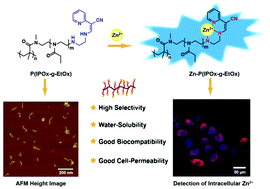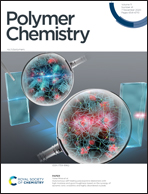A fluorescent sensor for intracellular Zn2+ based on cylindrical molecular brushes of poly(2-oxazoline) through ion-induced emission†
Abstract
Mobile divalent zinc, Zn(II), is an essential cofactor involved in mammalian biological processes. To understand the intrinsic action mechanism of mobile zinc, the development of a Zn2+-selective fluorescent probe that can detect mobile zinc via biological imaging is of great significance. We present here a novel Zn2+-selective fluorescent sensor based on poly(2-oxazoline) (POx) cylindrical molecular brushes with good water solubility and biocompatibility. The POx molecular brushes were end-capped by a Zn2+-responsive functionality, which can give efficient blue emission upon coordination with zinc ions. Fluorescence investigation indicates that the POx molecular brushes exhibit superior selectivity toward Zn2+ in comparison with most competitive heavy and transition metal ions. Due to the ease of cellular uptake that results from their unique molecular contour, POx molecular brushes are capable of detecting intracellular Zn2+ ions as demonstrated by living cell fluorescence studies.



 Please wait while we load your content...
Please wait while we load your content...